If your space requires custom-sized furniture, especially large-scale pieces — it can be very pricey. However, if you have basic carpentry and upholstery skills, as well as tools and time, building your own custom furniture such as a tufted ottoman with wood legs, can be a money-saving solution.
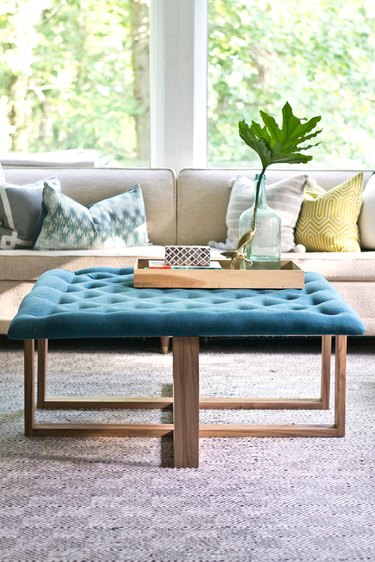
Video of the Day
Things You'll Need
20-foot one-by-four in a hardwood such as oak or poplar
Chop saw
Tape measure and pencil
Drill with 1/4-inch bits
Pocket hole tool and pocket hole screws
Wood glue
220-grit sandpaper
Choice of wood sealant, such as wax, polyurethane or stain
Circular saw or table saw to cut the plywood top (or get your plywood pre-cut at the home improvement store)
42-by-48-inch piece of 3/4-inch plywood (birch is recommended)
2-inch thick upholstery foam, 42 by 48 inches (may be purchased smaller and seamed together)
Sharp kitchen knife
Spray adhesive
5-inch needles, 1-2
2 yards of 54-inch-wide fabric, such as thick linen from the home decor fabric section
Batting
Button cover kit
50 buttons, 3/4-inch diameter
Upholstery thread
Staple gun
Scissors
6 angle brackets, 1 inch, with screws

Step 1: Measure and Cut the Base
Using a tape measure and pencil, mark six 16-inch sections, four 8.5-inch sections, and one 46.5-inch section on the one-by-four. The 16-inch sections will be the vertical legs of the base, and the 8.5-inch sections and the long piece will be the bottom of the base. Then cut with the chop saw.
Video of the Day
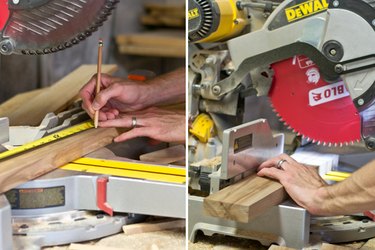
Step 2: Drill Pocket Holes
Using the pocket hole tool, drill two pocket holes on both ends of all the 18.5-inch sections and the long piece.
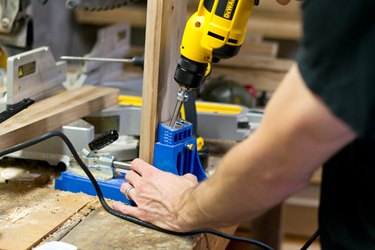
Step 3: Connect the Legs
Place a little wood glue prior to connecting the legs. Assemble them with pocket hole screws so that they are hidden. This will be the bottom of the base. Connect the bottom first. Attach the 18.5-inch sections to the long piece, as shown in the diagram.
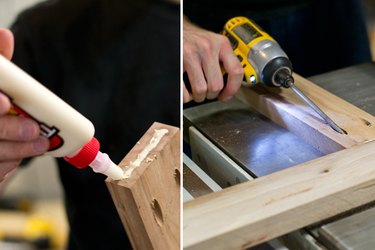
Then flip over and attach the 16-inch legs to the base with pocket hole screws, as shown in the diagram.
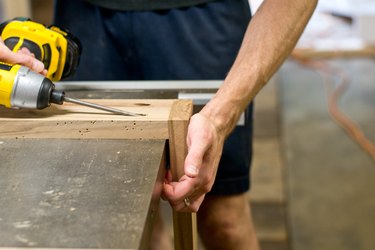
When the base is connected, sand with 220-grit sandpaper and, if desired, seal with clear wax, polyurethane or stain.
Step 4: Cut the Plywood Top
Most home improvement stores will make a few cuts in the store for free, so take advantage of that, if available. If cutting at home, use a table saw to cut the plywood to size, 42 by 48 inches. Or, raise the plywood off of the ground with a few two-by-sixes, clamp a straightedge in place and cut a straight line with a circular saw.
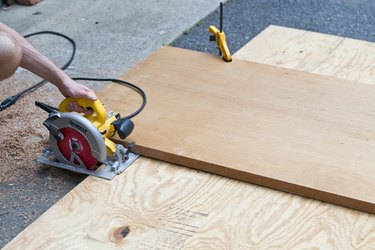
Step 5: Measure for Tufting

Follow the diagram and space the holes to prepare for tufting. Drill holes with a 1/4-inch drill bit.
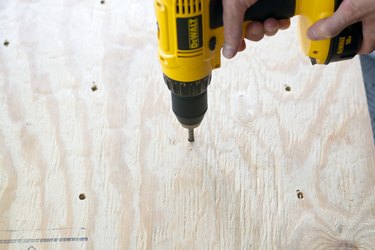
Step 6: Attach the Foam
Measure the 2-inch thick foam to size. Allow the foam to overhang 1 inch on all sides for a smooth edge. For the top, the foam should measure 44 by 50 inches. Using a very sharp kitchen knife (it should be sharp enough to cut through with one stroke), cut the foam to size. If your foam isn't wide enough, piece it together. Later it will be covered with batting to hide any lines.
Apply spray adhesive to the top of the plywood and the bottom of the foam. Center and place the foam on top of the plywood, pressing down to secure it.
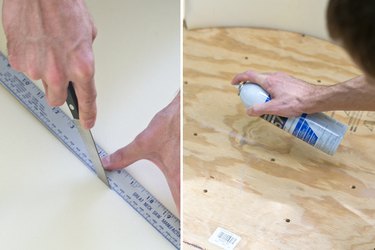
Step 7: Find the Holes
Cut batting and fabric so approximately 8 inches overhangs on each side of the top of the ottoman. Center and place the fabric over the foam. From underneath, find the hole and poke through with a long needle. Leave the needle in place.
Tip
Raise the ottoman off of the ground about 36 inches so that is is easier to work on — such as placing it between two ladders or chairs — but secure it so that it doesn't fall while working on it.
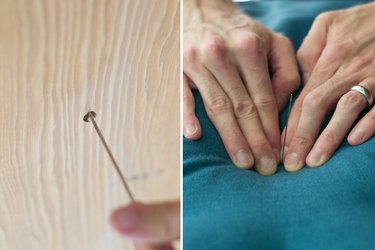
Step 8: Cover the Buttons
If desired, cover the buttons with coordinating fabric, following the instructions on a button cover kit. If using a button kit from a craft store (vs. upholstery buttons), apply a dab of strong glue inside prior to closing the button to strengthen the bond. Upholstery shops will also cover buttons if you'd like to save a step.
Using heavy-duty upholstery thread, thread the button and then place both ends of the thread through the end of the needle.
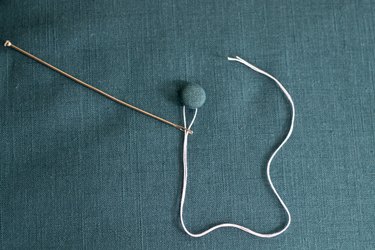
Step 9: Tuft the Buttons
Using the needle from the bottom as a guide, place a few staples around the hole on top of the fabric, as shown in the photo. This step isn't essential, but it will make it easier to push the buttons down. Remove the guide needle from underneath, and push the threaded needle through from the top. It is helpful to have two needles, one as the guide and one threaded with the button. Firmly push the button down from the top with your fingers to hold it in place.
Tip
- Enlist a helper to tuft. It is much easier with two people.
- Two needles are helpful but not necessary.

Step 10: Secure the Thread Underneath
Pull the thread tight from underneath and staple the thread to the bottom of the plywood. Staple three to five more times. Alternate the direction of the thread as you staple, as shown in the photo. This will ensure that the button is secure and doesn't slip. There is no need to pull after the first staple; simply keep the thread taught and staple three to five more times.
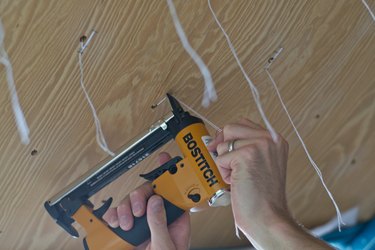
Step 11: Secure the Edges
Pull the fabric smooth and staple it underneath a few inches from the edge of the ottoman. Pull from the bottom of the fabric with your palm rather than your fingertips. This will prevent pulling and give a smoother finish. Staple about 6 inches from all corners.
Tip
Start stapling in the center of each side and work your way out to the end. Stop about 6 inches from the corner to finish those last.
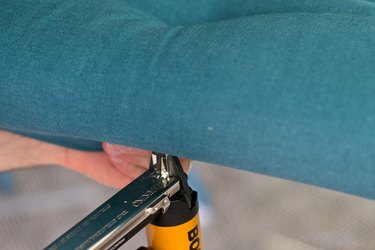
Step 12: Remove Excess Corner Batting
Remove all excess batting from the corners. This will make it easier to fold the fabric for a smooth finish.
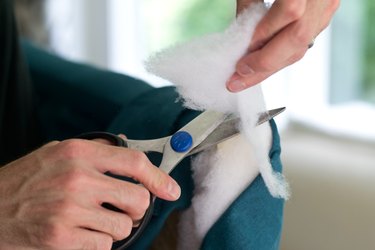
Step 13: Secure the Corners
Working toward the corner, pull and secure the fabric with staples. On the other end, fold the fabric and staple in place.
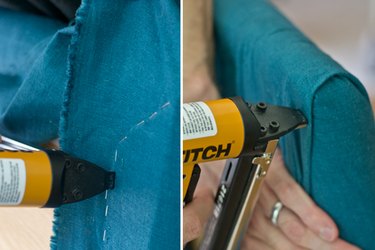
Step 14: Secure the Legs
Attach an angle bracket to the top of the inside edge of each leg on the base. Next, flip the upholstered top over, and center and place the base on the bottom of the upholstered top. Attach the ottoman to other end of the angle bracket with the screws included with the angle bracket.

Flip your ottoman over and accessorize with your favorite tray, books and accessories.
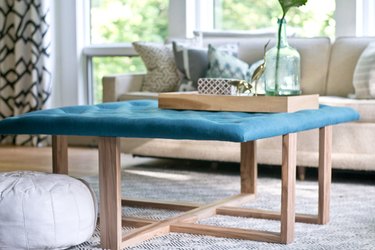
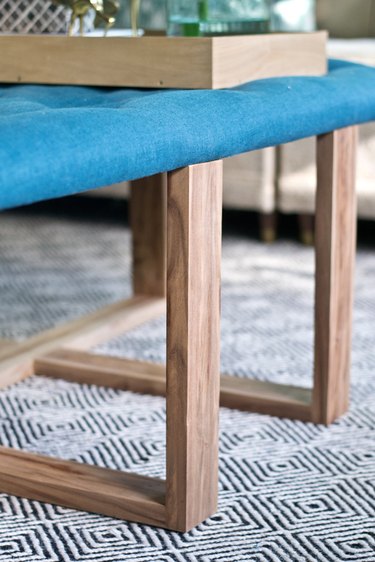
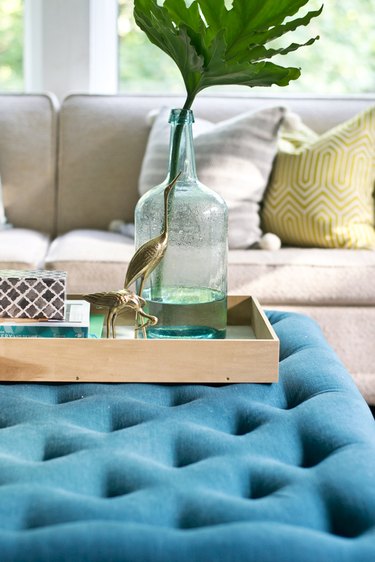
For more furniture building ideas, check out 10+ DIY Living Room Furniture Projects.